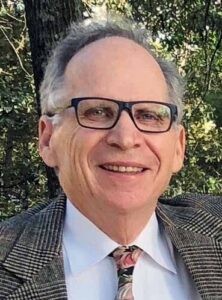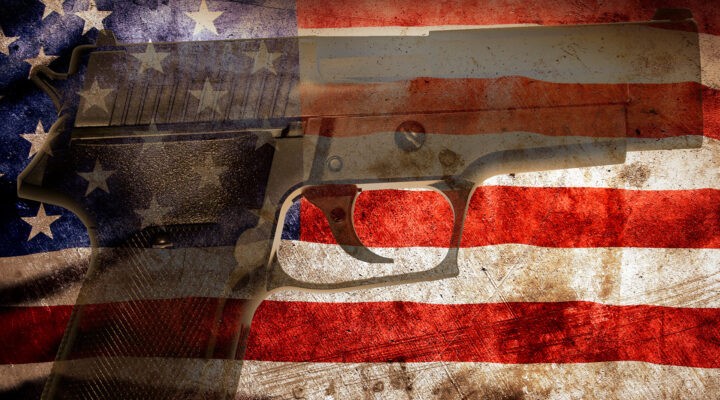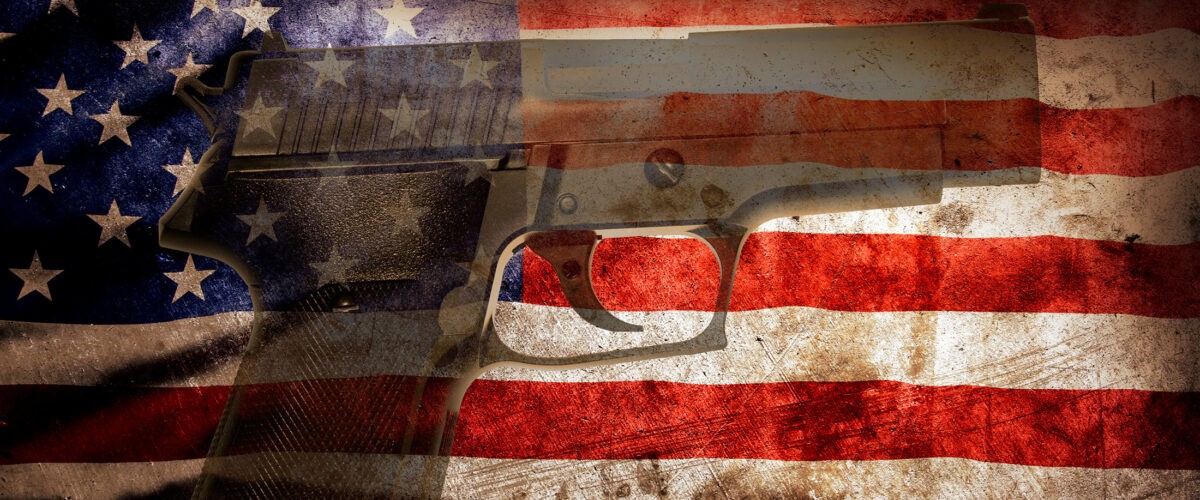We fight the “gun battle” in many ways. Some hurl statistics like darts, trying to puncture the other side’s position. Their opponents are adept at this, too, reminding us: “There are three kinds of lies: lies, damn lies, and statistics” (Mark Twain quoting Benjamin Disraeli).
That doesn’t negate all statistics, but when they become “weaponized” with the sole intent of penetrating their opponents’ hard heads, those who hurl them may forget the thickness of their own heads.
Clichés provide more ammunition: “Guns don’t kill people; people do”; and its rejoinder: “Guns don’t bleed, die or grieve; people do.”

Russell G. Waldrop
Clichés are easily memorized and can make some excellent points; but they often have meaning only for those who quote them so easily; likewise, the cleverly crafted “answers.”
Personal experiences, too, have their place. Marksmanship trophies, animal heads on the wall, and food on the table are justifying for one side. Funerals of friends and family are more than justifying for the other side. Often, there are not “two sides” at all. Many have experienced all these images.
Stories abound of “the good guy with a gun” taking down a “bad guy with a gun,” but “experts” report that innocent persons often are shot in such situations. One such positive or negative experience can cement that position forever.
Basic to the issue is the Constitution’s Second Amendment, unappreciated by many, yet elevated biblically to “Second Commandment” status by others.
When arguments fail to convince, God is brought in as back-up. Apparently, our rights and a host of deadly weapons fall under “God-given.” And the same God is called upon to heal the wounds that come with such “gifts.”
Supreme Court cases are touted. Comparisons are made to other countries, to different states, even to different sites of tragedy. Even highway deaths are compared to gun deaths.
As mental health becomes a factor in mass shootings, the Centers for Disease Control points out the national “epidemic” in gun deaths; and doctors want to ask patients if there is a gun in the home — as they do about drugs and alcohol. But the National Rifle Association rages about this.
Legitimate self and family defense are mostly understood, but “overkill” and “quick draw” factors often go unquestioned.
Calls to “arm everyone” or to “take up all the guns” are knee-jerk reactions often made after a mass shooting.
Arming teachers as a case study
If the movement to “arm teachers” succeeds, a new “R” might enter our traditional rhythmic academic pattern: “reading, writing, arithmetic, and revolvers.”
“If the movement to ‘arm teachers’ succeeds, a new ‘R’ might enter our traditional rhythmic academic pattern: ‘reading, writing, arithmetic, and revolvers.’”
Is this consistent with the biblical prescription of wisdom as our “guard and protection” (Proverbs 4: 5-6)? No one has a monopoly on wisdom, of course, but it does provide a starting point from which to evaluate arming schoolteachers.
No one advocates that just any teacher bring a pistol to class, certainly not those who don’t want the additional responsibility of shooting someone. But some are recommending specialized training and increased pay for teachers who might want to be armed and ready to defend their classes with gunfire.
Police take precious minutes to arrive and move in. Well-trained and armed teachers already would be on site; plus, they know firsthand the layout of the school and classrooms and could be in position quickly to take on the shooter(s).
However, arriving police may not know the good guys with guns from the bad ones during a gunfight. School police resource officers also would be on site already and in uniform, readily identifiable. Their training, financial support, prior police experience and relationship with students might be a better investment.
Other questions include the cost and source of extra pay, training and liability insurance for teachers, as well as any risk factors on other insurance policies. What “stigma” could come to “gun-toting” teachers or those refusing the position?
Then, there is the “dual career” issue. One involves compasses, protractors, chalk boards, pencils, the smell of crayons and other class paraphernalia; the other involves a trigger pull, a loud noise, the smell of gunpowder, a bleeding body on the floor, and the accountability that will come — even the accountability of having done nothing.
Is there a chain of custody for each gun during the course of the day or night? Are guns owned by the school or the teacher? Are they concealed or in open view? How close to the guns are students?
The arm-the-teachers plan creates a superficial parallel to other mass shootings where the same anti-gun-control arguments form a solid front. It also escalates our normal, perhaps childlike, fantasies of heroic rescue beyond realistic expectation; and it cements the “now-is-not-the-time” mantra heard after so many mass shootings until the issue fades.
The mental and emotional relationship between teachers and students cannot be switched on and off quickly, even at will; rather, it manifests itself spontaneously when students are threatened. Teaching, though, is where their skills and bravery lie, not with guns.
‘Do not be deceived’
In Galatians 6:7 we read: “Do not be deceived; God is not mocked, for you reap whatever you sow.” The Greek grammar also may be translated as: “Don’t deceive yourselves.”
What does this have to do with gun violence? Like many similar verses, it warns us to “test every spirit” before falling for myths. The grandparent of all gun violence myths is this: “Guns don’t kill people, people kill people.”
“The grandparent of all gun violence myths is this: ‘Guns don’t kill people, people kill people.’”
Notice how well-crafted it is. It could have said: “People kill people with guns” or “People with guns kill people” or even “Guns are used to kill people.” But, no, the grammatical structure is intentional.
The first part, “Guns don’t kill people” may be technically true. As they say, “Guns don’t walk up and shoot people,” although loaded guns with hair triggers and the safety buttons off have fallen from fence posts or tree stumps and discharged while the hunter was elsewhere. Interesting, but the wind or curious birddog gets us only to gun safety. What do we say when it falls off the kitchen table at home?
The second part of the motto, “people kill people,” is undeniable and seems to “baptize” the first part. It also diverts us from guns as enablers of human violence.
At that point we may be reminded that people kill people with knives and baseball bats, too. True enough, but we rarely hear of “drive by” knifings or baseball bat attacks. They don’t have the range of guns.
Notice, though, how far we have been moved psychologically from guns by the mere structure of the famous motto. It is here that the “multiple causes” diversion is often introduced with an added note of futility.
Yes, there are many causes of gun violence, some contributing more than others. Among those claimed are poor parental supervision, mental health issues, violent movies and video games, high taxes, financial insecurity taking fathers out of the home, prayer removed from schools, peer pressure, adult pressure, bullying, and on and on.
Any one of these may be used to divert the conversation from guns. When these are bundled together with added notes of helplessness and futility, many throw up their hands — as massacres continue.
Yet, the one common factor remains the same. “Don’t deceive yourselves,” the Bible says. When it comes to gun violence, it is about the guns.
Guns and roses
Shakespeare had Juliette bless Romeo’s last name with the modern paraphrase: “A rose by any other name would smell as sweet.” Is there a similar blessing for guns?
You may have noticed the sanitization process lately. Guns are no longer “weapons,” they are “tools.” The AR-15 is not an “assault weapon,” it is a “modern sporting rifle.” One series of it is called “the SAINT” (their caps). The original designation “AR” stood for “ArmaLite Rifle,” the company that made it, not for “Assault Rifle.”
There is nothing “lite,” though, about other names. Funerals are still funerals and coroners still list causes of death as “gunshot wounds.”
“This subtle and faulty logic divides the world into two groups: law-abiding citizens and criminals. Therefore, only criminals would have guns.”
In addition to softer gun talk, the myths continue. You’ve heard this one: “If guns are outlawed, only outlaws will have guns.”
This subtle and faulty logic divides the world into two groups: law-abiding citizens and criminals. Therefore, only criminals would have guns.
But consider: There is a sieve between these two false compartments that allows us to flow from one side to the other, even numerous times in life. Law-abiding citizens do break laws, and criminals do obey them. Everyone does both. Have we learned nothing from Jesus’ parable of the wheat and the tares?
Even a mass shooter was likely a law-abiding citizen until he pulled the trigger, thus representing both categories almost simultaneously. And that crime might have been prevented by enforceable gun control laws governing it.
When would criminals give up their guns? Many prison inmates know the dictum: “Use of a firearm in the commission of a felony can add five to 10 years at sentencing.” Some benefitted from it; others didn’t.
After release, they likely remember that mere ownership of a gun by a convicted felon can send them back to prison. They, and many others merely contemplating criminal acts, plan accordingly — without guns.
Built into this myth is the “slippery slope” fear that equates any amount of gun control, even safety requirements in the home, with eventual confiscation of all guns. Yet, the United States Supreme Court has ruled in favor of individual gun ownership rights (D.C. v. Heller; McDonald v. Chicago), exposing this myth.
We also hear the call to “enforce the laws we already have” rather than passing more. This is highly suspect in that those making this call often are the very ones who fought against those laws in the first place. Now they want those laws enforced but plead, “Just don’t make any more.”
If not at Easter … when?
As we approach Holy Week this year, the horror of mass shootings still lingers in our minds. This is consistent with the highly charged political and religious conversations Jesus had with his disciples after his resurrection.
So we examine another myth about guns: “The only thing that stops a bad guy with a gun is a good guy with a gun.”
We note here a change in tactics. Previously, we were distracted from guns to such “causes” as violent movies and video games, poor parental supervision, prayer being removed from schools, absentee fathers, mental health issues, bullying. Now, though, we hear “the only way” solution: more guns.
We also notice the ability to divide the world into two groups: “good guys” and “bad guys,” reminiscent of old black-and-white western movies where the cowboys wore the appropriately colored hats.
“The stereotypical ‘good guy with a gun saves the day’ is a rescue fantasy that misses what actually happens in such scenarios.”
The stereotypical “good guy with a gun saves the day” is a rescue fantasy that misses what actually happens in such scenarios. More often than not, the hero shoots the victim, a responding officer, an innocent bystander or himself; gets his gun taken or is shot by the “bad guy”; can’t be identified by police who shoot him; or panics and does nothing. Factually, several well-trained career police officers — all “good guys with guns” — can fire many shots at a perpetrator and miss with most or all of them.
Another myth involves “gun-free zones” that shooters seek out to perpetuate their crimes so they won’t be shot in the process. In reality, shooters usually have some association with the places of their crimes: attending school there, working there or knowing someone who does, a church because of personal religious or racial bias. Locations are not chosen because the shooter looked up the security features. They may even prefer dying in a shootout with police to dying by suicide. They also may feel less cowardly if someone can shoot back.
This Easter Sunday morning, we will have the opportunity to experience the resurrection of faith and discipleship. That could involve our “asking, seeking and knocking” our way through these dangerous myths that are leading us in the wrong direction.
Such resurrection would involve our mental processes and personal courage to think and act accordingly. But that’s always been a part of what Easter means.
Russell G. Waldrop is a retired pastoral counselor in Waynesboro, Va., and serves as first vice president of the Waynesboro branch of the NAACP.
Related articles:
While we’re talking about guns in America, let’s talk about our fear-based theology that also drives gun sales | Opinion by Rick Pidcock


